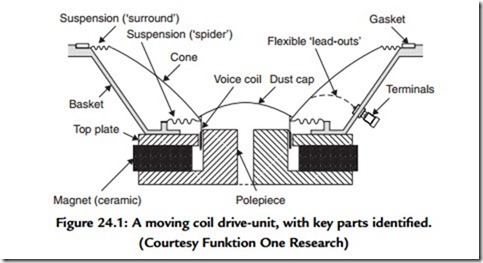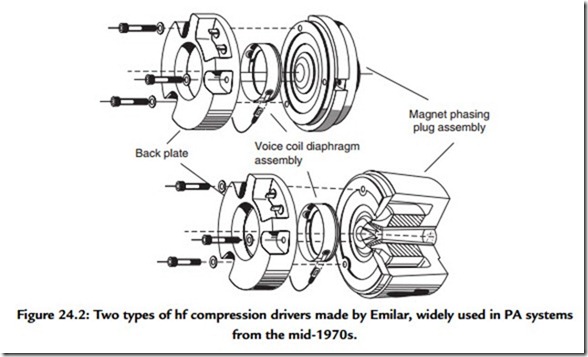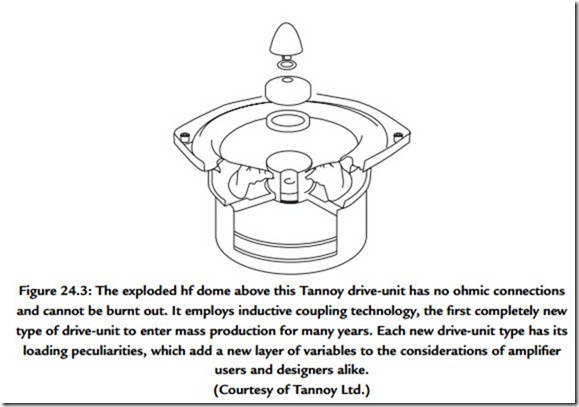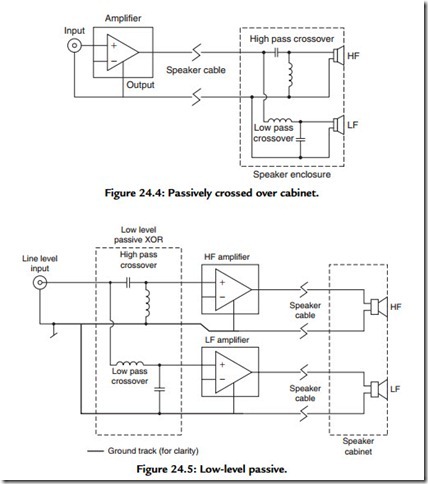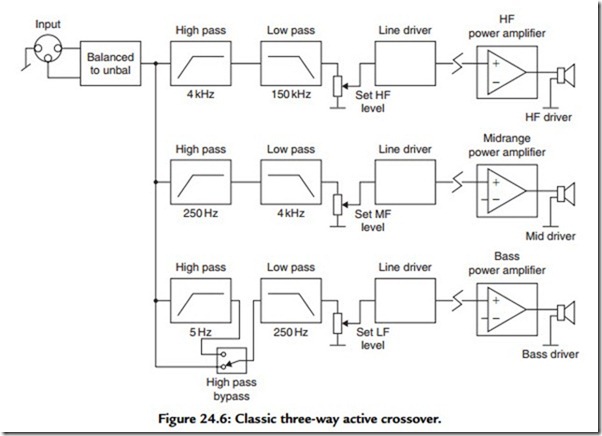Loudspeakers
Knowing a little about loudspeakers, the load that is audio amplifiers’ raison d’etre is a prerequisite to understanding amplifiers. In the following sections—indeed most of the rest of this chapter—those features of loudspeakers that most define or affect the design and specification of power amplifiers are introduced.
Loudspeaker Drive-Unit Basics
There are six main types of speaker drive-units or drivers used for quality audio reproduction. Another name for a driver is a transducer, a reminder that they transduce electric energy into acoustic energy via mechanical energy.
Cone Drivers
The most universal, everyday form of the “moving coil” or “electrodynamic” type of drive-unit (Figure 24.1) has a moving cone, with a neatly wound coil of wire (the “voice coil”) attached to its rear. The coil has to be connected to and driven by an amplifier. The coil sits in a powerful magnetic field and can move back and forth without rubbing against anything. When driven, a signal-varying, counteractive magnetic field is set up,
causing the coil and the attached cone to vibrate in sympathy with (as an analogue of) the driving signal. The principles are akin to an electric motor, except that the vibration is linear (“in and out”) rather than rotational.
Moving coil drive-units can be made in many ways. Most have to be mounted in some kind of enclosure before they can be used. Drive-unit size (strictly, the piston diameter) broadly defines frequency range. Most cone drivers range from 1″ (25 mm) up to 24″
(0.6 m) in diameter for use at high treble down to low bass. There are at least 15,000 different types of cone materials, textures, and weights available. Most are made of paper pulp, but plastics, metals, composite materials, and laminated combinations are also used. Every one sounds different and measures differently.
There are as many permutations again for the voice coil’s diameter, height, and wire gauge; the type of dust cap, magnet, the chassis, and the flexible jointing, called the surround (at the front), and centering device at the rear, the suspension or spider. With all the moving parts, ruggedness and stiffness are pitted against the need for agility, hence levity. This is the main reason why the radiating part is cone shaped. This shape can stiffen the most limp paper against the axial force applied to it by movements of the voice coil.
Compression Drivers
The second most common type of driver, at least in professional sound, is the compression driver (Figure 24.2). This is simply a specialized form of moving coil drive- unit. The depth of the cone is replaced by a much shallower and usually opposite-facing and dome-shaped radiating surface, called the diaphragm. The voice coil is attached peripherally between the edge of the dome and the suspension. This type is made for some midrange but mainly hf speakers, which are horn loaded. All bass bins and most midrange horns employ specially adapted but ordinary-looking cone drivers; these alone can handle the larger excursions required. A compression driver cannot handle more than very small excursions. To avoid large excursions and potential ripping of the
diaphragm, a compression driver must never be driven with a program having frequencies below its rated range and not driven without being attached to a suitable horn. Usually, the diaphragm is pressed out of a plastic film, or a phenolic resin-impregnated cloth or other composite, or from very light, but stiff metal, usually aluminum or else titanium or beryllium. Size ranges from about 6″ (150 mm) for midrange down to 1″ (25 mm) for high treble and above.
Soft and Hard Dome Drivers
The equal-second most common type of speaker drive-unit is familiar enough. It has an almost hemispherical diaphragm shaped like some compression drivers, but the dome is forward (like a fried egg) and nearly always working into free air. This is used on its own, instead of a small diameter cone, as a tweeter (hf drive-unit). The material can be any of those used in cone or compression drivers.
Common Voice Coil
The three types of drive-units discussed so far all have similar voice coils. They may range widely in weight, diameter (from 0.75719 up to 67150 mm), and power handling (commonly from 3 to 1000 W), but they will all mostly have a DC resistance of 5 to 10 ohms and a nominal (AC, 400 Hz) impedance of 8, 15, or 16 ohms.
The Ribbon Driver
The ribbon speaker is a fourth kind of electrodynamic drive-unit. Instead of a voice coil attached to the radiating part, the amplifier signal is connected across a length of flat (planar) conductor foil or “ribbon,” which is again placed in a magnetic field like a voice coil, but also radiates sound like a cone, diaphragm, or dome. Compared to ordinary voice coils, this arrangement can be lighter and certainly presents a much purer (“resistive”) impedance to the amplifier. The classic ribbon had a very low DC resistance and was transformer coupled. Modern ribbon speakers have longer strips, amounting to 3 or 5 ohms of near pure resistance, benign to most audio amplifiers connected to it. When “built big” as a panel loudspeaker, a ribbon drive-unit forms a wide-range loudspeaker in its own right, that is, no cabinet required. There is little breakup in the ribbons’ surface to mar the sonic quality. And, unlike other drive-units, absence of a cabinet means the sound source radiates as a dipole, that is, from both sides. This can be important to the amplifier, in far as room interaction can change the impedance seen by reflection. Small ribbon drive-units are used as tweeters. They may be horn loaded to magnify their rather low output. Sonic quality can be very high, although naturally favoring the reproduction of stringed instruments.
The Electrostatic Source
The electrostatic loudspeaker (ESL) employs the inverse or dual principle of the electrodynamic or “motor” types of drive-units that we have just looked at. The movement is provided by electrostatic (electric field) force rather than magnetic attraction and repulsion. The vibrating part is a thin, critically stretched sheet called the diaphragm.
The fixed part, after the capacitor it mimics, is called a plate. Electrostatic drivers are commonly made in the form of panels, like ribbon speakers. A power source (usually from the AC mains) provides the high EHT DC voltage of over 1000 V that is needed to polarize the plates. A high signal voltage swing is also required. This, together with isolation from the EHT, is attained by interposing a transformer. In practically sized and costed electrostatic speakers, the transformer and the diaphragm have a surprisingly limited capacity for handling high levels at low frequencies. In primitive designs, overdrive in the bass can cause the diaphragm to short against the opposite plate. In modern ESLs, the diaphragm is insulated. A well-known electrostatic employs an aggressive crowbar circuit for protection. If the ESL is subjected to potentially damaging high levels at low enough frequencies, this shorts the speaker’s electrical input, possibly blowing up the amplifier, or at least blowing a fuse or shutting down the music. Under most other conditions, the ESL appears as an almost purely capacitative load, with resistive damping across it.
The Piezo Driver
The two fundamental types of drive-unit “motor” looked at so far all date back (in principle) to the early years of this century, or even to the beginnings of the modern harnessing of electricity, 200 or more years ago.
The piezo drive-units’ principle is the dual of the familiar household act of creating large voltages by squeezing crystals. Although piezoelectricity precedes humankind, as it can occur naturally, it has only been widely harnessed in the past 50 or so years, first in crystal microphones and pickups and more recently in fuel-less “push button” gas fire lighting. The dual, or reverse process, that of making a crystal vibrate by applying electricity to it, was first harnessed by Motorola, who have been producing hf drive-units employing this principle since at least 1977. This type of drive-unit looks capacitative, rather like an electrostatic, but has a higher DC resistance so that it can draw no long- term power. Despite potentially useful high hf performance, since there is still a limited range of piezo drive-units, most being fitted to integral, out-dated horn designs, piezo tweeters are not used much in high-performance systems, but they are occasionally used in PA systems and may be found optimally applied in refined custom speaker systems.
The Motorola piezo element cannot be “burned out” by too much “power” as it presents a high impedance. However, it is rated at about 25 V rms, and excess voltage will quickly destroy the crystal. The crystal can even be harmed by room heating. For use with amplifiers having headroom above 25 V rms, operating two or three in series is suggested. This should not degrade damping as it would with a low impedance speaker.
Inductive Coupling
Eli Boaz at Goodmans, part of the TGI Group (comprising speaker manufacturers Tannoy, Goodmans, and Martin Audio in the United Kingdom) spearheaded the development of two-way drive-units where the hf driver is inductively coupled (inductive coupling technology or ICT). It comprises a radiator with a conductive collar (Figure 24.3). Placed within the bass/midrange voice coil, it acts as a single turn transformer, picking up magnetic field most efficiently at hf. This arrangement is limited to use at hf, but there is no need for a crossover, and it is highly rugged—a tweeter that cannot readily burn out.
Also, without having the capacitative loading region of a conventional tweeter (and the load dip of any passive crossover), an ICT driver’s load impedance at hf is benign.
Loudspeaker Sensitivity versus Efficiency
Loudspeaker drive-units have to be “packaged” to be usable in the real world. Together, enclosures and drive-units define the efficiency of the resultant loudspeaker. Efficiency (or its derivative, sensitivity) then decides the scale of amplifier power needed. With different high-performance loudspeaker types, efficiency varies over an unusually wide range of at least a hundredfold, from about 20% down to 0.2%.
Efficiency is not often cited, but can be inferred from the vertical and horizontal polar radiation patterns, the impedance plot, and the sensitivity. Sensitivity is the derivative of efficiency that makers use to specify “how much SPL for a given excitation.” In part, sensitivity is universally specified because it’s easier to measure. It is given as an SPL with a given input (nearly always 1 W) at a given distance at close range (1 m normally). So the spec is the one that reads: “Sensitivity 96 dB @ lw @ 1 m.”
For most domestic speakers, 96 dB is a high sensitivity but low for professional types. The sensitivity is but a broad measure of efficiency differences, since two factors are missing.
One is how the sound energy is spread in space. If it is all focused forward, sensitivity (dB SPL @ 1 W @ 1 m) is raised as the sound “density” at the measuring position increases. At low frequencies, rated sensitivity commonly falls as the sound radiation becomes more nearly spherical, while efficiency is unaffected.
Factor two is the impedance. Where mainly resistive, efficiency is about the norm, as computed by integrating the SPL over all the solid angles. But around the resonant frequency where the impedance changes rapidly from capacitative to inductive, efficiency is high, as little energy is dissipated.
With these four dimensions of variables (3D space + ID impedance), converting efficiency into sensitivity figures and vice versa is not straightforward. However, as a rough idea, an 86-dB @ l-W@ l-m rated domestic speaker is about 0.5% efficient. With a two-sided (planar) speaker, the efficiency might be the same 0.5% but sensitivity would ideally halve toward 80 dB.
Loudspeaker Enclosure Types and Efficiencies
Horn loading is by far the most efficient technique. It is between 10 and over 100 times more efficient than any others. “Efficiency” means it gives the most acoustic intensity for a given power input, from the amplifier. Only when a horn (or “flare”) is coupled to a transducer with a low output (e.g., a ribbon driver) is the overall efficiency not “streets ahead” of all the other driver-t-enclosure combinations.
The most efficient drivers are the familiar electrodynamically driven cone, dome, and compression types, particularly those with an optimum balance between the strength of magnetic and electric coupling, the levity of the moving parts, and the compliance of the suspension. In the midrange, some ESLs can be as efficient as the cone driver, both in the context of a refined domestic speaker.
The least efficient enclosures are:
1. None (this holds true at low frequencies only),
2. The sealed box (SB) or “infinite baffle” (IB), and
3. The transmission line (TL)—used to extend bass response.
Of these, the latter two are important, practical forms that have to be lived with. They can in any event be made relatively quite efficient by making the enclosure big. To some extent, Colloms’ law holds here: “Loudness (per watt or volt) is inversely proportional to bandwidth and smoothness.”
This is fine until we come to consider the refined horn speakers, which do not attempt 50% efficiency, and where a minimum of three types are needed to cover the audio band. While at least 10 times more efficient, there is little or no bandwidth narrowing over ordinary speakers.
Compression and piezo drivers are those usually coupled to horns (flares) and may need no other boxing or at least not any specific enclosure, as their rear chamber is usually already sealed. Sound radiation is then mainly defined by the horn, subject to mounting.
Ribbon drive-units may be also horn mounted or, if “planar” types, then along with ESLs, they may be simply mounted in a frame that has little effect on the sound radiation, which is dipolic, that is, two sided, like a harp’s.
The other two types of drive-units—the cone and soft dome—are usually mounted in closed (“infinite baffle” or “sealed box”) enclosures or, in the case of cone drivers alone, in ported (“Thiele-small,” “vented,” or “reflex”) enclosures.
Cone drivers are also used “coupled to” horns—either midrange, or bass (“bins”). In practice, as the rear of the cone’s basket mounting frame is open, and the fragile magnet is also unprotected, cone drivers in bins and horns are almost always mounted inside the overall enclosure.
Horns, transmission lines, sealed and vented boxes, and other loading types may form complete loudspeakers in free permutation. Of these, only combinations of horns or sealed boxes can cover the full audio frequency and dynamic range within their own family, that is, without involving each other or the other types.
Loudspeaker Configurations: A Résumé
Few or no single loudspeaker drive-units offer overall, high-performance audio reproduction. The nearest contender is an ESL or ribbon type panel, which can work as the sole drive-unit for the kinds of music that have no loud, low bass content. But to listen
without restriction and risk of damage to every other kind of music, two, three, or more drive-units must be used to cover low, medium, and high frequencies (which from 10 Hz to 20 kHz span a wavelength range of some 2000-fold!), and over the 120-dB+ dynamic range required for high-performance sound reproduction.
Matching Levels
Often, the sensitivities (loudness) of the individual units that are optimum for each frequency band differ. Commonly, the tweeter is more sensitive than the driver covering bass/midfrequencies. If efficiency is unimportant, the mismatched sensitivities (which would otherwise cause an uneven, “toppy” frequency response) may be overcome by adding a series “padding” resistor in line with the hf drive-unit (tweeter).
Parallel Connection
Alternatively, in touring PA and wherever else efficiency matters, or wherever high SPL capability is sought, an overall flat response may be attained by using two, parallel- connected bass/mid drive-units. Applicability is always subject to coherence in the acoustic result, hence suitable mutual positioning of the paralleled drivers, so they work together. If “ordinary” drivers (i.e., electro-dynamic types) are used, a 15 or 16 Q rating will be likely chosen, so the resultant load is about 8 Q rather than 4 Q if the paralleled drivers were each the usual 8 Q.
Again, always subject to coherence in the acoustic result (and thus suitable mutual positioning, generally closer than a quarter of the shortest wavelength), drive-units or complete speakers can be paralleled across either a given amplifier or, when this runs out of drive capability, across amplifiers ad infinitum that are driven with an identical signal and have either identical or acoustically justifiable different gains. Despite this, the fewer drive-units or speakers reproducing a given program in a given frequency range, the better the sonic results. As is so often the case in high-performance sound reproduction, least is best—if it is usable.
Why Crossovers?
When two or more drive-units are used to cover the audio range, it is usually very important that they only receive program over their respective, intended frequency ranges. Program at other frequencies must be omitted, as it will usually degrade a drive-unit’s sonics by exciting resonances and subharmonics. At moderate to high drive levels, physical damage is also likely. The “frequency division” or “frequency conscious routing” that ensures different drivers receive their intended range, and not other frequencies, is the crossover (no relation to crossover distortion).
The crossover may also perform phase shifting or signal delay in one or more bands. Principally this is to synchronize (UREI use the phrase “time align”) the signals delivered by the drive-units, for example, because the sound from some has slightly further to travel.
A variety of crossover types exist, with the more sophisticated designs aiming to have the bands meld neatly in the crossover regions, without boosting or cutting any frequencies.
Crossover Point (XOF)
The crossover frequency or “point” is chosen by speaker designers on the basis of:
1. Power handling. Drops dramatically if the XOF is too low for the higher driver.
Caused by the exponential increase in excursion as LF limits are reached.
2. Distortion. For the same reason, rises rapidly for the higher driver below a comfortable XOF.
3. Frequency response, both on- and off-axis. If either of these changes abruptly, near the proposed XOF, the XOF had better be moved. But with some drive-unit combinations, there is no ideal XOF.
Passive Crossovers
In the majority of domestic speaker systems, but particularly where low cost or simplicity is paramount, the crossover is passive (unpowered) and operates at a “high level,” being placed within and supplied as part of the speaker cabinet (Figure 24.4).
In this form, the crossover comprises physically large and heavy, high voltage-rated capacitors, high current-rated inductors (coils), and high power-rated resistors.
Passive Low Level
It is possible (but not very common) to have a passive crossover operating at line level installed before the signal enters the power amplifier, or otherwise before the power stage (Figure 24.5). The crossover parts can then be smaller and lighter, as the voltage and current ratings (that in part determine size) can then be 30 to over 100 times lower. This is a fine arrangement for all-integrated active cabinets.
Speaker cabinet
Otherwise, in ordinary “mix and match” sound systems, one problem arising is that because the crossover is physically divorced from the speaker, careful connection is needed. Another, less daunting, is that any existing, passive high-level crossover
component values cannot be simply transferred, as they will have been “tweaked” to best suit the vagaries of the drive-units’ impedances.
Active Crossovers
The active crossover (first suggested by Norman Crowhurst in the 1950s) takes the preceding concept a stage further. Frequency division is accomplished actively. This means using active devices—and a DC power source—to provide filtering in a highly predictable manner. For example, the filters are able to work in an ideal environment, having well- defined and resistive loading. This and the filter function are defined potentially very precisely by active electronics, usually employing high NFB (Figure 24.6).
The main disadvantage of active crossover systems is cost, not just of the active crossover, but of the added amplification and cabling. In DIY domestic setups there is also the bulk of equipment (if using, say, three stereo amplifiers, placed centrally, or six mono block amps and two mono crossovers, half to be placed by each speaker) and their cabling. Such inconvenience is irrelevant in concert sound systems, and even in recording studios. It is
also absent in active powered enclosures and is the rather the reverse—1 integrated active cabs are “plug in and go” systems. For everyone else, more care is needed when connecting up an active system, taking care that the drive units are going to be fed their appropriate band. In professional systems, multipin speaker and line connectors are commonly used so that the two or more frequency bands’ connections are always routed correctly.
Notable advantages compared to the common, high-level passive crossover are:
1. Reduced “congestion” and similar intermodulation distortion symptoms as each power amplifier handles only a section of the audio range.
2. Differences in driver sensitivities (considered under “matching levels,” see earlier discussion) are ironed out and without compromise, except the
requirement for, or use of amplifier headroom, by simply adjusting gain controls.
3. Higher dynamic headroom by diversity, as the program peaks occurring in the respective out-of-band frequency ranges do not steal any headroom. Also, brief clipping (overdrive) of the bass band (etc.) has little effect on clarity when the other bands are not driven into clipping at the same time.
4. Amplifiers are connected directly to their respective drive-unit(s). There are no reactive components (i.e., the passive crossover) to steal current, but the drive-unit’s impedance dips may still demand significant current headroom from the amplifier.
5. The ease and capability of creating highly conjugate, highly matched, and closely toleranced crossover functions.
Of these, the low-level passive crossover potentially has all the same advantages—except possibly this last item.
Active Manifestations
Active crossovers commonly take one of three forms. In pro-audio, “the crossover” is commonly used packaged in its own box, like other signal processors, as a stand alone.
As a power amplifier presents a (literally) well-placed opportunity to share a box and a power supply, a few power amp makers offer a pluggable option or “octal socket,”
where a crossover module or card can be retrofitted. Often, the performance of the card’s filtering (e.g., the frequency and slope rate) may be decided upon by the user. This is often a low-budget option limited to installation work, but while it can save money, it need not be shoddy. If carried out with as much care as any crossover is due, turning an amplifier into a “speaker-driving filter” has the advantage of minimizing superfluous hardware and signal path complexity.
Otherwise, the active crossover, along with the power amplifiers, is placed in the loudspeaker enclosure. This creates an “active enclosure,” “active speaker,” or “Tri-amp cab” (if three way; else “bi-amped-cab,” “quad-amped-cab,” etc.) that has the advantage of hiding the complexity and offers a fait accompli, but takes away the flexibility that touring PA users often need.
Active systems are widely used in pro-audio, for installed and touring PA systems, and studio control room monitors. In nearly all cases, stand-alone active crossovers, discrete power amplifiers, and individual enclosures are brought together. In high-end hi-fi, discrete active systems are comparatively rare, except in DIY circles. Active speakers are becoming somewhat more common, at least in the United Kingdom and Europe.
Bi-wiring
Bi-wiring is a “part-way house” to having a low level active (or passive) crossover.
A separate speaker connecting wire is provided for each drive unit, or for each frequency band (Figure 24.7). This lessens interaction and intermodulation that is otherwise caused by communal speaker cabling.
Other Networks
Whether the crossover is passive and high level, passive and low level, or active, other components may be associated with each drive unit:
1. DC protection capacitors are connected in series with drive-units to block steady current flow should a DC voltage appear across the box’s, the speaker’s, or the driver’s input terminals. They are not required for hf (and mf) drivers with passive crossovers, where the high and “bandpass” filters already include the required series capacitor as part of the crossover.
In some designs, more complex, active crowbar circuitry is used, in order to obviate the need for a series capacitor.
2. Zobel and other “conjugate matching” networks. Comprising networks of capacitors and resistors, and less often inductors, these act to smooth out the impedance variations of the drive-units, either singly or altogether, and as seen by the preceding crossover and also amplifier.
3. Music overdrive protection—in some designs, a light bulb, usually a rugged 12-V type, is connected in series with hf drive units, which in practice require protection most of all. At worst, the light bulb will be quicker, easier and less expensive to change than the hf driver or diaphragm. The effect the light bulb has on sonic quality can be small and sonically benign if the lamp is not visibly glowing during normal loud passages. “Auto resetting” “ thermal trip devices,” alias Ptc (positive temperature coefficient) thermistors, are also used. These are usually in the form of a cement-coated disc. At room temperature, they exhibit a low resistance. When eventually tripped by excess current, the hot resistance increases rapidly to about 100-fold, and the protected driver’s power dissipation drops 10,000-fold ox pro-rata. The effects on sonic quality of series ptc thermistors are as yet questionable.
Other Protection
Loudspeakers have also been protected by add-on boxes, containing historic power- reading circuitry, for example, which crudely opens a relay in line with the speaker or line level signal if the drive-unit is seen heading toward a burnout.
